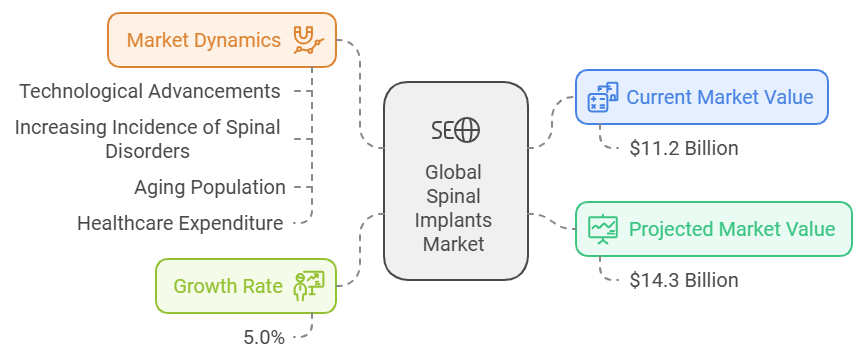Introduction
The spinal implants market is experiencing significant growth, fueled by the increasing prevalence of spinal disorders and advancements in minimally invasive spine surgery. With innovations in spinal fusion implants and spinal fixation devices, this market offers vast opportunities for stakeholders. This post explores key trends, market drivers, and emerging opportunities in the spinal implants sector.

Key Trends in the Spinal Implants Market
- Rise of Minimally invasive spine surgery has transformed patient outcomes by reducing recovery times and minimizing complications. This shift towards minimally invasive procedures aligns with a growing preference for surgical options that require shorter hospital stays.
- Technological Advancements in Spinal Fixation Devices New developments in spinal fixation devices have improved surgical precision, offering better outcomes in spinal stabilization. These advancements help surgeons treat complex cases more effectively, expanding the capabilities of modern spine care technology.
- Growth of Biocompatible and Patient-Specific Implants Innovations in materials have led to the production of biocompatible, patient-specific implants. Customization in spinal surgery devices ensures a more tailored fit, enhancing both safety and efficacy for patients undergoing spinal reconstruction.
Download an Illustrative overview
Market Drivers
- Increasing Incidence of Spinal Disorders Degenerative spine conditions such as herniated discs and spinal stenosis are becoming more common due to aging populations. These conditions drive demand for vertebral implants and spinal fusion technology, essential in stabilizing and aligning the spine.
- Shift Toward Outpatient Surgery As healthcare systems push to reduce costs, more spinal surgeries are being performed in outpatient settings. This shift supports the adoption of advanced spinal implants designed for use in minimally invasive settings, allowing patients to return home sooner.
- Technological Integration in Spinal Surgery Robotics and navigation systems are becoming integral to spine surgery, improving precision in implant placement. These systems contribute to market growth by enhancing the success rates of spinal implant procedures, particularly in complex cases.
Opportunities for Market Growth
- Expansion in Emerging Markets Rising healthcare expenditure in developing regions presents new opportunities for spinal implant providers. As access to medical technology improves, there is potential for growth in the spinal implants market across Asia-Pacific, Latin America, and other emerging economies.
- Focus on Research and Development Continuous R&D investment is essential in refining spine treatment devices to meet evolving patient needs. Innovations focused on improving biocompatibility, durability, and ease of implantation can provide companies with a competitive edge.
- Growth in Aging Population With a growing elderly population worldwide, demand for treatments for degenerative disc disease and other age-related spine conditions is increasing. Companies that offer reliable, minimally invasive solutions are likely to see sustained demand in this segment.
Get 10% Free Customization on this Report
Conclusion: The Road Ahead for the Spinal Implants Market
The spinal implants market is poised for growth as technological advancements continue to address evolving patient needs. From minimally invasive solutions to customized, biocompatible implants, companies that remain at the forefront of innovation are well-positioned to succeed. By aligning with trends and tapping into emerging opportunities, stakeholders in the spinal implants sector can help shape the future of spine care technology.
